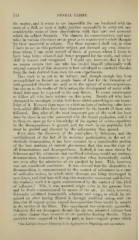Page 744 - My FlipBook
P. 744
754 DENTAL CARIES.
the matter, and it seems to me impossible for one burdened with the
cares of a full, or even a light, practice successfully to carry out any
considerable series of these observations with that care and accuracy
which the subject demands. The chances for contaminations and mis-
takes in various directions are so great as to require one's whole thought
for their successful avoidance. For these reasons I shall not, in what
I have to say on this particular subject, put forward my own observa-
tions where I can avail myself of those of persons whom I know to
have been better situated and better prepared for the work, and whose
skill is known and recognized. I would say, however, that it is by
no means certain that one who has busied himself principally with
original research of this character is best calculated to construct theories
from the facts derived from even his own experiments.
This work is as yet in its infancy, and, though enough has been
accomplished to furnish an ample basis of fact for the formation of
well-grounded theories not only as to the agency of micro-organisms,
but also as to the modes of their action, the development of many addi-
tional facts may be expected in the near future. It seems unnecessary
to follow all who have written on this point. Nearly all who have
attempted to investigate in this field have added something to our know-
ledge of it. Even in those cases in which no facts of enduring value have
been added difficulties have been illustrated for the benefit of those who
followed. But, after all, the most important part of the w^ork has been
done by those in no wise connected with the dental profession, and it is
to them we must go for a knowledge of the agency of micro-organisms
in the decompositions in general, and the work in our particular field
must be guided and directed by the information thus gained.
Ever since the discovery of the yeast-plant by Schwann, and the
establishment of the fact of its necessary participation in the act of
alcoholic fermentation, it has been assumed by a considerable portion
of the best students of natural phenomena that this was the type of
all fermentations and decompositions. Indeed, it was soon shown by
Schwann and his colaborers that sterilized solutions Avould not undergo
decomposition, fermentation, or putrefaction Avhen hermetically sealed,
nor even after the admission of air purified by heat. This, hoAvever,
was not considered conclusive. It was claimed that the disposition to
decomposition is communicated by the contact of substances in a state
of molecular motion, by which their elements are being rearranged in
new forms, and that heat will stop this molecular movement and destroy
the tendency until it is again communicated by the contact of this kind
of influence.' This, it was asserted, might exist in the gaseous form
and be freely comnmnicated by means of the air. In 1854, however,
Schroeder sterilized fermentable solutions and soups, to which he ad-
mitted air after having filtered it through sterilized cotton, with the
idea that if organic germs caused decomposition these would be caught
in the meshes of the filter. This experiment was eminently successful.
Solutions did not decompose, though the air was admitted without heat
or other cliange than removal of the particles floating therein. These
particles were supposed to be—in part, at least—organic germs wdiich
' See Liebig's Organic Chemistry in Us Application to Physiology and Agriculture.


